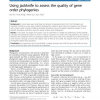Free Online Productivity Tools
i2Speak
i2Symbol
i2OCR
iTex2Img
iWeb2Print
iWeb2Shot
i2Type
iPdf2Split
iPdf2Merge
i2Bopomofo
i2Arabic
i2Style
i2Image
i2PDF
iLatex2Rtf
Sci2ools
BMCBI
2010
2010
Using jackknife to assess the quality of gene order phylogenies
Background: In recent years, gene order data has attracted increasing attention from both biologists and computer scientists as a new type of data for phylogenetic analysis. If gene orders are viewed as one character with a large number of states, traditional bootstrap procedures cannot be applied. Researchers began to use a jackknife resampling method to assess the quality of gene order phylogenies. Results: In this paper, we design and conduct a set of experiments to validate the performance of this jackknife procedure and provide discussions on how to conduct it properly. Our results show that jackknife is very useful to determine the confidence level of a phylogeny obtained from gene orders and a jackknife rate of 40% should be used. However, although a branch with support value of 85% can be trusted, low support branches require careful investigation before being discarded. Conclusions: Our experiments show that jackknife is indeed necessary and useful for gene order data, yet so...
| Added | 08 Dec 2010 |
| Updated | 08 Dec 2010 |
| Type | Journal |
| Year | 2010 |
| Where | BMCBI |
| Authors | Jian Shi, Yiwei Zhang, Haiwei Luo, Jijun Tang |
Comments (0)

